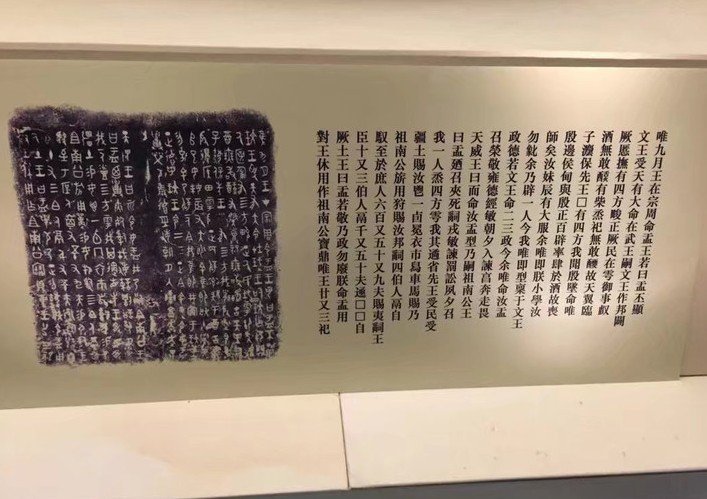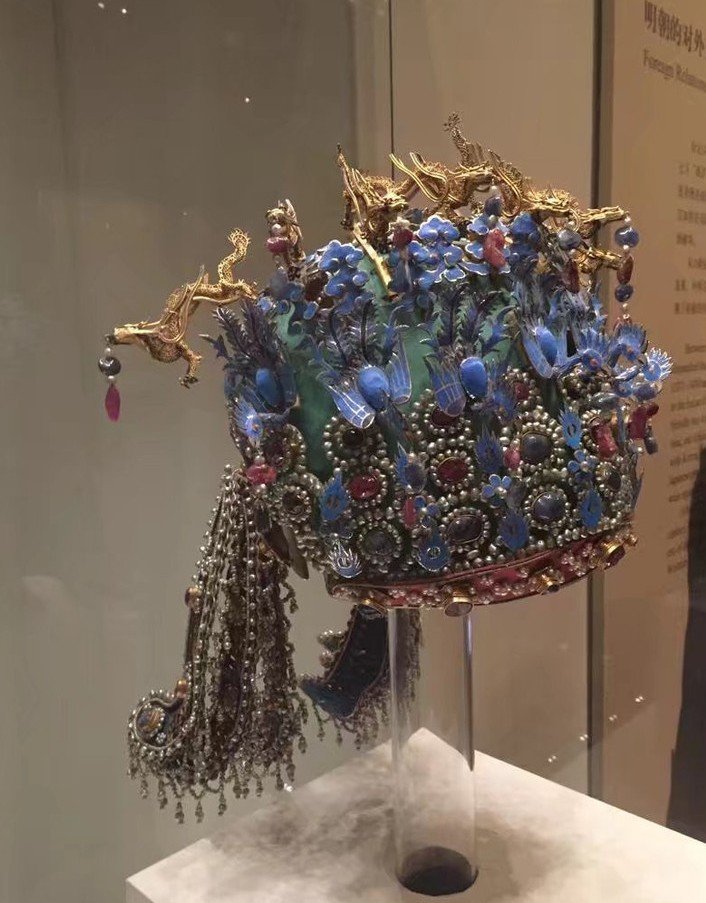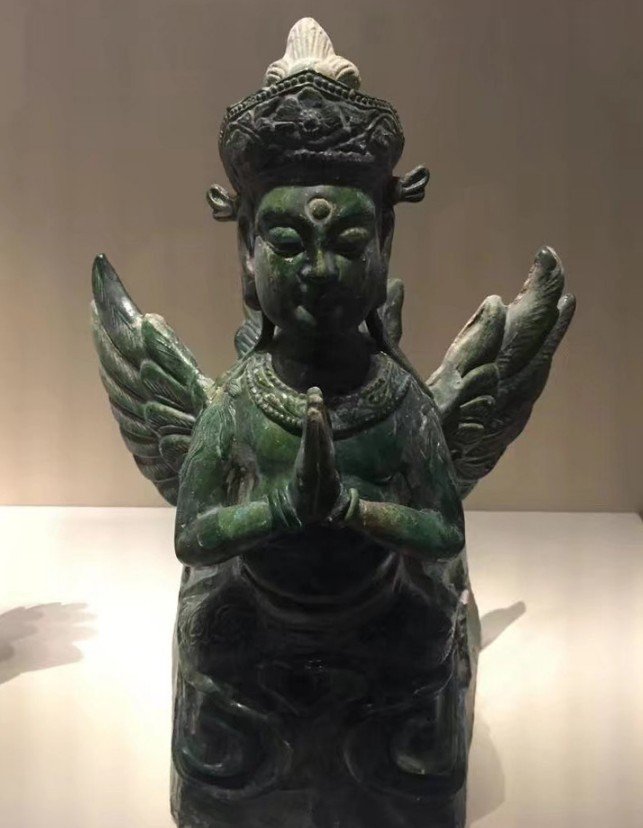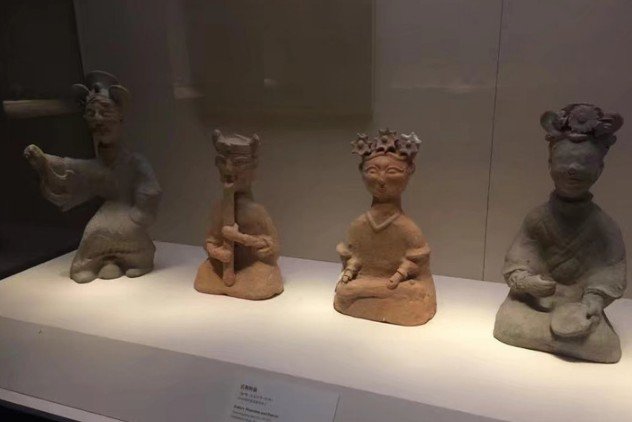 Recently fascinated by CCTV's "National Treasure" show, New Year's Day went to the Nanjing Museum, returned to Beijing's weekend went to the China National Museum! Just to the east of Tiananmen Square!
Recently fascinated by CCTV's "National Treasure" show, New Year's Day went to the Nanjing Museum, returned to Beijing's weekend went to the China National Museum! Just to the east of Tiananmen Square!
When the underground passage just met, go very neat, someone called: cool!
The total construction area of the National Museum of China is nearly 200,000 square meters. The number of Guo Bo collections is over 1 million pieces and the number of exhibition halls is 48 pieces. It is the largest single building in the world and one of the most abundant collections of Chinese relics. The scale of the world's museums in the forefront. Can be made online booking, SMS booking and on-site ticket three ways, are free! In January 2002, the State Administration of Cultural Heritage issued the "Catalog of Prohibited Expatriate Exhibitions and Cultural Relics", stipulating that there will be 64 national treasures in the country permanently banned from going abroad for exhibitions, of which 7 will be exhibited at Guobo all the year round, Treasures of the town!
In January 2002, the State Administration of Cultural Heritage issued the "Catalog of Prohibited Expatriate Exhibitions and Cultural Relics", stipulating that there will be 64 national treasures in the country permanently banned from going abroad for exhibitions, of which 7 will be exhibited at Guobo all the year round, Treasures of the town!
National treasure number name Time unearthed time and place
1, painted stork fish stone ax Figure pottery Neolithic 1978Year Linru County, Henan Province, Yan Village
2, Tao Yingding Neolithic Taipingzhuang, Huaxian County, Shaanxi Province, 1957
3, after the mother of copper Ding Ding late 1939 Anyuan City, Henan Province, Officer Village
In 4, Lvli Western Zhou DynastyThe early 1976 unearthed in Shaanxi Lintong
5, Dachang Dingxi Zhou Kang Wang Qing Dynasty light room in Meixian County, Shaanxi Province
6, Qipi white dish Western Zhou Dynasty Qing Dynasty Shaanxi Baoji 虢 town Xichuan Division
7, Xiaojing Jing Empress Feng Guan Ming 1957 Changping County, Beijing Dingling
After the mother of copper Ding - the world's largest bronze! After the bronze Fang Ding (formerly known as "Secretary Wu Ding"), because of the insides of the abdomen was inscribed with the inscription "Hou Mu-e" named archaeologists through the study of the bronze, and Oracle records that Ding Ding wall in the inscription "after the mother of the five" in the word, "mother of pearl" is the Empress Wu Ding's concubine maid's temple number. As can be seen from the inscriptions, the latter is the euphemism Dingwu Shang two sons ancestral or progenitor to worship their mother and womanhood.
After the bronze Fang Ding (formerly known as "Secretary Wu Ding"), because of the insides of the abdomen was inscribed with the inscription "Hou Mu-e" named archaeologists through the study of the bronze, and Oracle records that Ding Ding wall in the inscription "after the mother of the five" in the word, "mother of pearl" is the Empress Wu Ding's concubine maid's temple number. As can be seen from the inscriptions, the latter is the euphemism Dingwu Shang two sons ancestral or progenitor to worship their mother and womanhood. Although there is an inscription in the Ming dynasty, the calligraphic style is rigorous, and the calligraphy and the zhang law are very simple and plain. Both the pen and the book are very simple and elegant. Very beautiful level, is the representative of the Western Jin Dynasty before the Western Zhou Dynasty, coupled with a huge shape, dignified style, magnificent and majestic, so the work presents a magnificent momentum and magnificent pattern, so as the world's attention.
Although there is an inscription in the Ming dynasty, the calligraphic style is rigorous, and the calligraphy and the zhang law are very simple and plain. Both the pen and the book are very simple and elegant. Very beautiful level, is the representative of the Western Jin Dynasty before the Western Zhou Dynasty, coupled with a huge shape, dignified style, magnificent and majestic, so the work presents a magnificent momentum and magnificent pattern, so as the world's attention. The inscription contains Kang Wang Zhou Yu Wang to describe the king, Zhou Wu king of the founding experience. It is believed that Wenwang and Wuwang were able to establish their country with excellent performance, mainly because their vassal never drink, and sacrifice, conscientious and respectful, and the lesson of Wang's subjugation lies in indulging in wine. As a result, he told his followers that his ancestors should follow the example of his loyalty to help the royal family and give him service, horses, wine and state affairs and human beings. Meng in the inscriptions for this tripod is also to sacrifice his grandfather Nan Gong. Great Yu Ding Ming is the historian of the Zhou Dynasty seal system and the relationship between the king and the subordinate important historical materials, historians have always been valued.
The inscription contains Kang Wang Zhou Yu Wang to describe the king, Zhou Wu king of the founding experience. It is believed that Wenwang and Wuwang were able to establish their country with excellent performance, mainly because their vassal never drink, and sacrifice, conscientious and respectful, and the lesson of Wang's subjugation lies in indulging in wine. As a result, he told his followers that his ancestors should follow the example of his loyalty to help the royal family and give him service, horses, wine and state affairs and human beings. Meng in the inscriptions for this tripod is also to sacrifice his grandfather Nan Gong. Great Yu Ding Ming is the historian of the Zhou Dynasty seal system and the relationship between the king and the subordinate important historical materials, historians have always been valued. After the ditch Dingding tripod on the left is the child, because of the wall near the mouth with the inscription "dragon" named. So far found the largest Shang Dynasty round tripod. "Zi Longding" and "Secretary mother generous Ding" side by side, one circle, called the Shang Dynasty bronze double wall. Zi Long Ding is now found in the Shang Dynasty bronze dome tripod body in the largest one, but also with the "dragon" inscriptions the earliest bronze, excellent casting process, the preservation phase is perfect, is the best of Shang and Zhou bronzes.
After the ditch Dingding tripod on the left is the child, because of the wall near the mouth with the inscription "dragon" named. So far found the largest Shang Dynasty round tripod. "Zi Longding" and "Secretary mother generous Ding" side by side, one circle, called the Shang Dynasty bronze double wall. Zi Long Ding is now found in the Shang Dynasty bronze dome tripod body in the largest one, but also with the "dragon" inscriptions the earliest bronze, excellent casting process, the preservation phase is perfect, is the best of Shang and Zhou bronzes. Celestial beings, the early Western Zhou Dynasty famous bronze, also known as "Dafeng 簋" or "朕 簋." The Qing Dynasty years unearthed in Shaanxi Pixian County (now Baoji City Meixian) in the end of casting inscription 8 lines 78 words, a record of a major historical event occurred in more than 3000 years ago, this historical event is the king of Zhou Wu hair in the cut 纣 After the ceremony, the ceremonial sacrificial ceremonies were held. After the sacrifice was blessed by the ancestors and the father Wenwang, they succeeded in cutting down and succeeded in establishing the dynastic dominance.
Celestial beings, the early Western Zhou Dynasty famous bronze, also known as "Dafeng 簋" or "朕 簋." The Qing Dynasty years unearthed in Shaanxi Pixian County (now Baoji City Meixian) in the end of casting inscription 8 lines 78 words, a record of a major historical event occurred in more than 3000 years ago, this historical event is the king of Zhou Wu hair in the cut 纣 After the ceremony, the ceremonial sacrificial ceremonies were held. After the sacrifice was blessed by the ancestors and the father Wenwang, they succeeded in cutting down and succeeded in establishing the dynastic dominance.
"Ancient Chinese Buddhist statues art" is a permanent exhibition of the National Museum, and "the ancient Chinese bronze art," the same hall.


Ancient China Exhibition exhibited 2026 cultural relics, including 521 first-class cultural relics. The exhibition takes the replacement of dynasties as the context and takes the precious cultural relics as the core to show the endless developmental characteristics of the Chinese civilization and demonstrate the historical process by which people of all nationalities jointly create a multi-ethnic country. The exhibition is divided into ancient period, the Xia and Shang Western Zhou Period, the Spring and Autumn Period, Qin and Han Dynasties, the Three Kingdoms and the Southern and Northern Dynasties, the Sui and Tang Dynasties and Five Dynasties, the Liao and Song Dynasties, the Jin and Yuan Dynasties, the Ming and Qing Dynasties. Sapphire six dragonfly ring double wash, is the corners of the two corners of the washing associated as a whole, the rest of the hexagonal dragonflies on the dragon, each dragonfly title Yuhuan a simple and dignified style.
Sapphire six dragonfly ring double wash, is the corners of the two corners of the washing associated as a whole, the rest of the hexagonal dragonflies on the dragon, each dragonfly title Yuhuan a simple and dignified style.
Qing Emperor Qianlong pastel hollow center bottle, pastel for the glaze color, also known as soft color, began in Kangxi (AD 1662 ~ 1722), Sheng Yu Yongzheng years (AD 1723 ~ l735 years). It is from the development of multicolored, which is characterized by a change of multicolored single-line flat coating of the painting, some of the screen with glass white powder, then painted with a variety of colors. This open-hearted revolving bottle is a new type of bottle created by the Qing Dynasty. It is a revolving inner bottle that is set inside the perforated bottle. When the inner bottle is rotated, different images can be seen through the through holes of the outer bottle.


 Jade Indian Emperor Seal, the emperor's seal of the Qing Dynasty called "Royal treasure", had placed in the Forbidden City Temple of the cross, by a specialized agency - Shang Bao Si to manage.
Jade Indian Emperor Seal, the emperor's seal of the Qing Dynasty called "Royal treasure", had placed in the Forbidden City Temple of the cross, by a specialized agency - Shang Bao Si to manage.

In 1957, archaeologists unearthed Dingling, unearthed Xiaochen, filial piety Coronet each 2, respectively, 3 dragon 2 phoenix, 12 dragon 9 wind, 9 dragon 9 phoenix and 6 dragon 3 phoenix. Burial fashion in octagonal Zhu lacquer box, and then were loaded into four funerary objects in the box. According to Hongwu, Yongle custom, the Queen's crown for the 9 Dragon 4 phoenix, but unearthed from the unearthed in kind and custom, we can see the Wanli Crown service system has changed. Which belongs to the end of 9 Xiaolong 9 Coronet Wong Coronet. The filial piety queen is decorated with nine golden dragons, eight spots of Tsui Kam Fung, more than 100 red sapphires, and more than 5,000 pearls. It is one of the four crown crowns unearthed in Dingling. The four crowns were banned from going abroad by the State Administration of Cultural Relics Exhibition artifacts. This Phoenix crown with paint bamboo tied into a cap to Silk as fabric, the front decorated with nine golden dragon, the mouth of the bead drops, there are 8 points Tsui Kam Fung, the back also has a Jinfeng, a total of 9 Dragon 9 phoenix. Behind the lower part of the various ornaments Tsui to embellished gold Dragon Ball drop three Bo Tuo. This crown embeds a total of more than 100 natural ruby unprocessed, more than 5,000 pearls.
The filial piety queen is decorated with nine golden dragons, eight spots of Tsui Kam Fung, more than 100 red sapphires, and more than 5,000 pearls. It is one of the four crown crowns unearthed in Dingling. The four crowns were banned from going abroad by the State Administration of Cultural Relics Exhibition artifacts. This Phoenix crown with paint bamboo tied into a cap to Silk as fabric, the front decorated with nine golden dragon, the mouth of the bead drops, there are 8 points Tsui Kam Fung, the back also has a Jinfeng, a total of 9 Dragon 9 phoenix. Behind the lower part of the various ornaments Tsui to embellished gold Dragon Ball drop three Bo Tuo. This crown embeds a total of more than 100 natural ruby unprocessed, more than 5,000 pearls.
 Ming Xuande filigree enamel Lianzhu lotus 觚, this out of halberds shape correct, steady glaze pure, extremely thick gold, for the Xuande filigree enamel typical artifacts.
Ming Xuande filigree enamel Lianzhu lotus 觚, this out of halberds shape correct, steady glaze pure, extremely thick gold, for the Xuande filigree enamel typical artifacts.
Ming Jiajing multicolored fish algae tank, this colorful porcelain tank painted lotus flap pattern on the shoulder week, abdomen painted banana leaves a week, the abdomen painted lotus, algae, fish, the overall picture shows the density. Blue with the bottom of the regular script "Ming dynasty Jiajing system."

Next is the Liao Song Xia Jin Yuan period ~ ~
In order to highlight the scientific and technological achievements of the Song Dynasty in the exhibition, the National Museum of China showed an acupuncture bronze man. Wang Weiyi was a famous medical scientist in the Northern Song Dynasty who served as the doctor of medicine in Renzong and Yingzong. He compiled and published a series of "Acupoints acupuncture meridian diagram of new cast bronze medal" to summarize the previous acupuncture and moxibustion studies in the Song Dynasty. In the same year, Wang Weiyi cast two identical acupuncture bronze people in 1027, and later people called it "Song Tianshin acupuncture bronze person". The original has disappeared, and now this collection of acupuncture in the National Museum of copper, is said to be the Ming orthodox years, strictly faithful Northern Song Dynasty St. acupuncture bronze original, cast from. Buddhist sculpture reached its peak in the Tang Dynasty. Stone carving to the Song Dynasty began to decline, while wood carving is a sudden emergence, in particular, the most outstanding woodcarving Guanyin. Beautiful posture, face kind and amiable ~
Buddhist sculpture reached its peak in the Tang Dynasty. Stone carving to the Song Dynasty began to decline, while wood carving is a sudden emergence, in particular, the most outstanding woodcarving Guanyin. Beautiful posture, face kind and amiable ~
Xixia green glaze kiss, the two parts of the ancient buildings are ridges, glazed bright, mighty shape, is the largest and most complete building components unearthed in the Western Xia Imperial Tombs. This is a building component, tall, was the first dragon body shape, the first and the body of the fish were fired molding, the whole body decorated with scales, Shi green glaze, glazed bright, mighty vivid.
Western Xia Wen 敕 Burning horse Bronze 敕 card, the Xixia Wen on it as "敕 burning horse", meaning "敕 令 驿站 gallop day and night." 敕 Burning horse license is Xixia pass the court and the military instruments, order communications staff "pass." 敕 card consists of two round bronze card can be verified. A deposit of the court, a metropolitan Inn, coincidence after the messenger can carry this letter to send a letter. Western Xia enamel Pentagram Corolla frequency gamma, the first bird body sculpture Jia Ling frequency gamma, is a kind of Buddhist bird of paradise. It is rumored that the voice sounds beautiful and melodious, melodious song, better than the everlasting bird, the Buddhist scriptures also known as the United States sound birds or Mute birds. In our country, the image of JiaLing frequency gamma first appeared in the Northern Wei Dynasty stone carvings, Tang Dynasty Dunhuang murals and copper mirror also see its shape.
Western Xia enamel Pentagram Corolla frequency gamma, the first bird body sculpture Jia Ling frequency gamma, is a kind of Buddhist bird of paradise. It is rumored that the voice sounds beautiful and melodious, melodious song, better than the everlasting bird, the Buddhist scriptures also known as the United States sound birds or Mute birds. In our country, the image of JiaLing frequency gamma first appeared in the Northern Wei Dynasty stone carvings, Tang Dynasty Dunhuang murals and copper mirror also see its shape.

 The next is the Sui, Tang and Five Dynasties ~
The next is the Sui, Tang and Five Dynasties ~
Wu Yue ~ Golden Bronze Goddess of Mercy statue. Wu Yueguo (907 - 978) was one of the ten nations during the Five Dynasties and was capital city of Qiantang (Hangzhou). Its heyday, including the scope of this whole territory of Shanghai, Zhejiang, throughout the territory of Suzhou and northeastern Fujian. Calendar three generations of five kings, to AD 978 Natsumi Song, the founding of seventy-two years. Wu Yue rule less than a century, but in the territory of Hangzhou has built more than 150 monasteries and dozens of towers, Hangzhou has become a well-known Buddhist scenic resort laid the foundation. Tang Sancai, ancient Chinese ceramic burning process treasures, the full name Tang Dynasty three-color glazed pottery, is popular in the Tang Dynasty a low-temperature glazed pottery, glaze with yellow, green, white, brown, blue, black and other colors, Green and white-based, so people used to call it "Tang Sancai." Due to Tangsan the earliest, most unearthed in Luoyang, also known as "Luoyang Tang Sancai," said.
Tang Sancai, ancient Chinese ceramic burning process treasures, the full name Tang Dynasty three-color glazed pottery, is popular in the Tang Dynasty a low-temperature glazed pottery, glaze with yellow, green, white, brown, blue, black and other colors, Green and white-based, so people used to call it "Tang Sancai." Due to Tangsan the earliest, most unearthed in Luoyang, also known as "Luoyang Tang Sancai," said.

 The town is a monster beast common in ancient tombs in China. There are animal faces, human faces and antlers. It is a kind of burial ground set for the purpose of protecting the souls of the deceased from being invaded by the ghosts.
The town is a monster beast common in ancient tombs in China. There are animal faces, human faces and antlers. It is a kind of burial ground set for the purpose of protecting the souls of the deceased from being invaded by the ghosts.
 On the back of a tall, white camel, sit two figurines on each side of the left and right, and a male figurine in a green robe in the center. Quartet musicians look focused, playing Hu music. Central dancer swing arm sleeves, seems to be a Hop and dance. People's face, hands are not glazed, painted to open phase to describe the details. The white camel builds strong, dynamic nature, applying brown glaze to the mane's ministry. Works novel, unique style, tall, typical representative of the Tang Dynasty social customs and superb artistic achievements.
On the back of a tall, white camel, sit two figurines on each side of the left and right, and a male figurine in a green robe in the center. Quartet musicians look focused, playing Hu music. Central dancer swing arm sleeves, seems to be a Hop and dance. People's face, hands are not glazed, painted to open phase to describe the details. The white camel builds strong, dynamic nature, applying brown glaze to the mane's ministry. Works novel, unique style, tall, typical representative of the Tang Dynasty social customs and superb artistic achievements.
Next, the Three Kingdoms, the Southern and Northern Dynasties ~
Three Kingdoms (Shu) music and dance figurines
 Pottery figurines occupy an important position in the ancient sculpture artwork, is a kind of ancient tombs sculpture art. As early as the Primitive Society, people began to mud-kneading the human body, animals, etc. together into the furnace and pottery together. Warring States period, with the decline of the system of sacrificial, pottery figurines to replace sacrificial burial.
Pottery figurines occupy an important position in the ancient sculpture artwork, is a kind of ancient tombs sculpture art. As early as the Primitive Society, people began to mud-kneading the human body, animals, etc. together into the furnace and pottery together. Warring States period, with the decline of the system of sacrificial, pottery figurines to replace sacrificial burial.
Three Kingdoms (Wu) Tao Yuan falls ~ This pottery courtyard has the front hall, after the main room, on both sides of the wing; front and back doors have a wall, the front door is built above the gatehouse, the gatehouse there are "General Sun Gate also" 6 scribe Text; corner four corners each have a corner house, gatehouse and corner house is used to guard the courtyard. Although Tao Yuanlu is a burial ground, it should be imitated by the architectural forms of the time. The owner of this tomb may be Wudu captaincy of Dongwu in the Three Kingdoms Period, Jing Zhou of Jingzhou. This type of courtyard model unearthed in the grave room of Sun Wu's clan, so some experts think that this courtyard model is the unique funeral objects of Wu clan.
 The Northern Dynasties ~ Tauren antlers gold step shake, this gold calf antler step shake crown at the time not only a fashion, but also a status symbol. Step shake is one of the important headdresses of ancient Chinese women. It is mostly made of jade and other materials and is in the shape of branches. Exquisitely crafted ornaments are decorated with flowers, birds and animals on the branches. As the wearer walks, the accessory flicker with the tremor of the walk, hence the name "step shake."!
The Northern Dynasties ~ Tauren antlers gold step shake, this gold calf antler step shake crown at the time not only a fashion, but also a status symbol. Step shake is one of the important headdresses of ancient Chinese women. It is mostly made of jade and other materials and is in the shape of branches. Exquisitely crafted ornaments are decorated with flowers, birds and animals on the branches. As the wearer walks, the accessory flicker with the tremor of the walk, hence the name "step shake."!









































